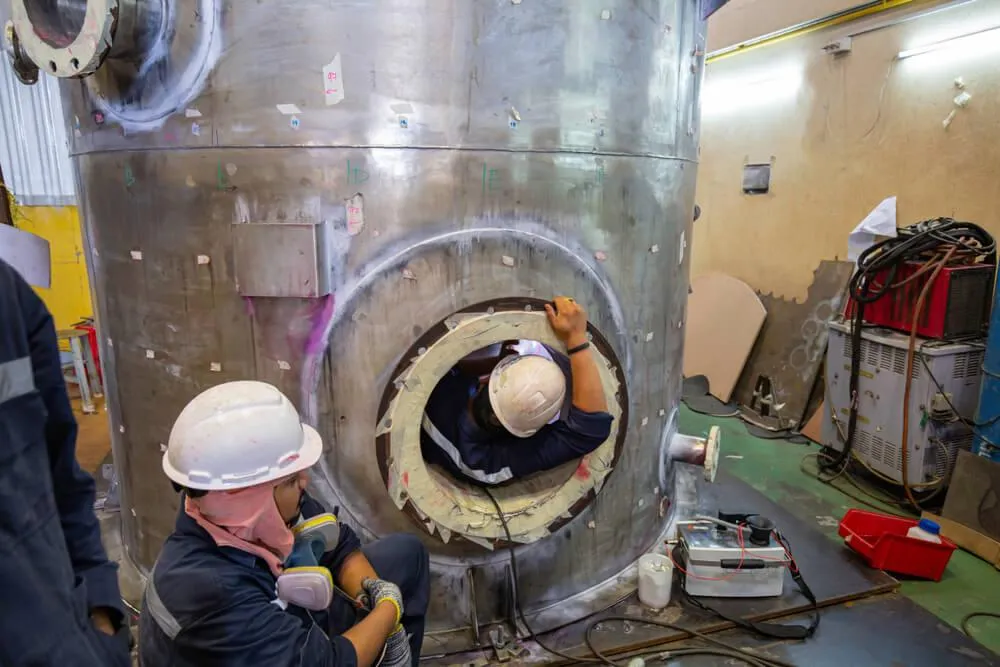
What are the federal requirements for confined space training?
According to OSHA’s website, confined space is defined as “limited or restricted means for entry and exit and is not designed for continuous occupancy.” In heavy industry, “confined spaces” can encompass a variety of different things. Some common examples of confined spaces in heavy industry can include tanks, vessels, hoppers, vaults, pits, manholes, tunnels, equipment housings, ductwork and pipelines. So, why does heavy industry require training for occupying a confined space? To enter a confined space without the right training is not only illegal but could cause serious injury and in severe cases even death. The purpose of training is so that entrants can be properly informed of potential risks and hazards. With the right training, entrants can accurately assess their own safety during work operations.
What types of heavy industry employees are required
to obtain confined space training (CST)?
How frequently should training occur?
The type and frequency of necessary heavy industry employee training can depend on two factors. These include whether the training is regulatory mandated or employer based. Employers must ensure compliance with laws at the local, state and federal levels. For more detailed information on OSHA’s confined space regulations, read here.
Confined space training requirements set forth by OSHA
1910.146(g)(1) — Employers must provide employees with CST training. The training is so that employees understand the skills needed to safely perform job duties in confined spaces.
1910.146(g)(2) —Employers must provide employees with training before the employee is given job duties in confined spaces, before there are changes in duties, and wherever there are changes that pose hazards unfamiliar to the employee. Training must also be provided when the employer suspects employees are not abiding by the confined space entry procedures or if an employer suspects an employee does not possess full knowledge of the procedures.
1910.146(g)(3) — Training should be sufficient enough to prepare employees for safe and knowledgeable operation of job duties in confined spaces. New training must be provided to employees as necessary.
1910.146(g)(4) — Employers must make sure that employee training has been completed. Assurance of completion should include the trainee’s name, the signatures of the trainers and the dates training took place. The completed training documents must be available to employees.
Basin Safety can help ensure that your employees are
meeting federal confined space training requirements
Basin Safety offers a variety of services and products, including our Confined Space Entry and Operations training and Confined Space Supervisors/Rescue Teams service. We’re committed to helping companies grow their safety goals and helping them achieve those goals. We also believe in the power of safety metrics, providing adaptive training, promoting safety culture and providing highly accessible data.
Contact our team today for more information about confined space training programs and requirements or to learn how we can help your business with a variety of field services.
Archives
Categories
Benzene Testing
Bloodborne Pathogens
Breathing Air Systems
Certification Process
Confined Space Attendants
Confined Spaces
Construction Equipment Operators
Electrical
Environmental Compliance
Excavation and Trenching
Fire Extinguisher Training
Forklift Operator
Hazcom Workplace Safety
HAZWOPER
Hearing Protection Training
Heavy Equipment
Hydrogen Sulfide
Lone Worker
Lone Worker Solutions App
Monitoring
Oil and Gas
Oil Drilling
Online Training Confined Spaces
Permit-required
PPE
Radiation Safety
Rescue Equipment
Rescue Team
Safety Consultants
Safety Devices
Safety Tracking
Safety Training
Site Inspections
Training 1
Training 2
Training 3
Training 4
Training 5
Uncategorized
Virtual Access to Safety Data
Waste Haulers
Confined Space Rescue
Mental Health
VISIT US
202 48th Ave SW, Williston, ND 58801
2740 Sims St. Suite B Dickinson, ND 58601
(701) 572-8140

BASIN SAFETY CONSULTING CORPORATION
Basin Safety believes in shared excellence. We are accountable to our core values:
● Pioneering Excellence Everyday
● Supporting each other to put customers first
● Asking the right questions, to ensure the greatest results.
Basin Safety Consulting © 2025. All rights reserved.
Powered By Upleveled Strategies

BASIN SAFETY CONSULTING CORPORATION
Basin Safety believes in shared excellence. We are accountable to our core values:
● Pioneering Excellence Everyday
● Supporting each other to put customers first
● Asking the right questions, to ensure the greatest results.
VISIT US
202 48th Ave SW, Williston, ND 58801
2740 Sims St. Suite B Dickinson, ND 58601
(701) 572-8140
Basin Safety Consulting © 2025. All rights reserved.
Powered By Upleveled Strategies
